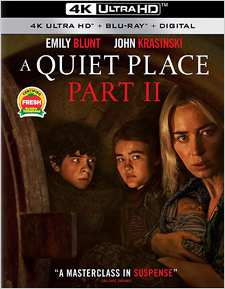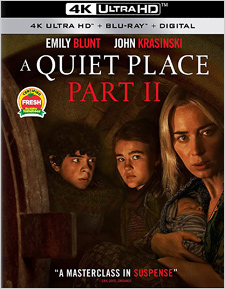Quiet Place, A: Part II (4K UHD Review)

Director
John KrasinskiRelease Date(s)
2021 (July 27, 2021)Studio(s)
Platinum Dunes/Sunday Night Productions (Paramount Pictures Home Entertainment)- Film/Program Grade: B
- Video Grade: A
- Audio Grade: A
- Extras Grade: C
Review
Set in the immediate aftermath of the alien invasion depicted in A Quiet Place (2018), John Krasinski’s A Quiet Place: Part II follows the surviving members of the Abbott family, who flee the ruins of their rural New York farm in the hope of finding safety with a family friend, Emmett (played by Cillian Murphy), who’s taken shelter in an old steel mill. But as Evelyn (Emily Blunt) and her children enter the grounds, her son Marcus (Noah Jupe) steps in a bear trap that’s part of the place’s defenses. The marauding aliens hear his screams and attack, but Marcus manages to get them all into his bunker just in time. He doesn’t want them to stay however, especially when he sees that Emily is carrying a newborn child. But Emily’s teenage daughter Regan (Millicent Simmonds), who is deaf, decides to take matters into her own hands. Her father Lee (Krasinski) discovered that the sound-sensitive aliens can be stopped by high-frequency audio feedback, so Regan takes it upon herself to find a boat that will carry her to an island just off the coast where a radio station has continued broadcasting music throughout the invasion. Her hope is that she can transmit the feedback over the air and thus save her family... and everyone else as well.
Normally, when I write a film review, I prefer to take a more scholarly, third-person approach. But in this case, I can’t really address this sequel without taking a moment to talk about my reaction to John Krasinski’s original film. And the honest truth is, I didn’t care much for it. Now, that’s not to say that I disliked it, or that I wasn’t impressed by the cast and Krasinski’s first effort as a filmmaker. Nor do I dislike alien invasion horror, nor did the original film lack for effective suspense. But when my wife and I sat down to watch it, the opening set piece (which I don’t want to spoil here for those who may not have seen the film yet—and you should obviously watch that film before this one)… well, when it happened, we both laughed out loud. In what was supposed to be a shocking and deeply unsettling moment that would set the stage for the entire viewing experience, we both found the scene so overwrought and ridiculous that, suffice it to say, we were thrown out of our immersion in the film. And we never really got back into it.
The good news here is, A Quiet Place: Part II is a better viewing experience. By splitting up its already vulnerable characters, the entire story becomes more tense. And by centering the film around Regan’s efforts to save her family (and thus follow her father’s example), the protagonist becomes instantly more interesting. In addition, a clever use of flashbacks allows us to see what happened on Day 1 of the invasion, which makes the story that resumes here beginning with Day 474 more meaningful—that’s context we never really got in the original film. Never mind the fact that the invasion itself makes no logical sense. I mean, it’s not like the aliens seem to have come to Earth for food or other resources. They just appear determined kill everything that makes sound. But what the hell; if one simply accepts this film in the spirit of the classic B-movies of the 1950s, it doesn't have to make sense. It just has to entertain. This time, entertain is exactly what it does. What’s more, young Millicent Simmonds is absolutely terrific—as are Blunt and Jupe (who reprise their roles), and Murphy and Djimon Hounsou (who join the cast). And thankfully, nothing breaks the immersion this time.
A Quiet Place: Part II was shot mostly on 35 mm photochemical film using Panavision Panaflex Millennium XL2 cameras with anamorphic lenses, though some scenes were shot in Super 35 format, and others were captured digitally in the ARRIRAW codec (at 3.4K) using the Arri Alexa Mini. The film was finished as a native 4K Digital Intermediate at the 2.39:1 aspect ratio for theaters (though the theatrical release was delayed for over a year due to the COVID-19 pandemic). For its release on Ultra HD, Paramount has graded the image for high dynamic range (both Dolby Vision and HDR10 are available on this disc). The resulting image quality is excellent on the whole, with a nice uptick in fine detail and texturing over the standard Blu-ray image—an improvement that’s visible in everything from skin and fabric, to stone and woodwork, and even dense foliage (safe for a bit of anamorphic softness around the edges of the frame). Image grain is light but organic. The expanded contrast of HDR results in very bold highlights and deeply dark yet detailed shadows. The wider gamut lends a measure of added vibrance and realism to the color palette too, not to mention greater variety in its subtle hues and shadings. As is often the case, the Dolby Vision option offers just a bit more depth and nuance, but it’s not something you’d really notice unless you were directly comparing the two different HDR presentations side by side. The important thing is that this is a highly pleasing and cinematic image.
Primary audio on the 4K disc included in an English Dolby Atmos mix that’s every bit as impressive. Dynamics are what really matter here, as the mix can go from whisper-quiet to bombastic in an instant, given the nature of the story. In the quiet moments, subtle atmospheric effects abound—insect noises, wind, water, etc. But when the aliens approach, their clicking sounds move in from discrete directions and then the creatures’ subsequent screams overwhelm the soundstage. That stage is wide and fully-hemispheric, with the height channels completing the overhead immersion and adding a bit of lift in set pieces (especially notable in the cavernous steel mill environment). Bass is firm and muscular, lending everything a satisfying sonic heft and foundation. The film’s score is restrained but is offered with excellent fidelity. And the dialogue is clear and clean, though given the fact that the characters are mostly whispering, you’ll want to make sure you have the volume up sufficiently. Additional audio options include English Audio Description, as well as 5.1 Dolby Digital mixes in Czech, German, Castilian Spanish, Latin Spanish, French, Quebec French, Italian, Japanese, Hungarian, Polish, and Thai. Optional subtitles are available in English, English for the Hearing Impaired, Malay, Cantonese, Czech, Danish, German, Greek, Castilian Spanish, Latin Spanish, French, Quebec French, Italian, Japanese, Korean, Hungarian, Mandarin, Dutch, Norwegian, Polish, Portuguese, Romanian, Finnish, Swedish, and Thai.
There are no extras whatsoever on Paramount’s 4K UHD disc, but the package also includes the film in 1080p HD on a Blu-ray. And that disc adds the following:
- Director’s Diary: Filming with John Krasinski (HD – 9:38)
- Pulling Back the Curtain (HD – 3:47)
- Regan’s Journey (HD – 6:19)
- Surviving the Marina (HD – 5:00)
- Detectable Disturbance: Visual Effects and Sound Design (HD – 8:26)
Unfortunately, the extras here are nearly as lackluster as they were on the first film’s home media release. The Director’s Diary isn’t really a director’s diary, it’s just a few minutes of Krasinski talking about his experience working on the film, and we briefly see the filming of a couple key scenes. The rest of this is just glossy EPK material. There’s barely enough content here for an HBO First Look. The film certainly deserves better. You do at least get a Digital copy code on a paper insert in the packaging.
Fans of A Quiet Place should find much to like about this sequel. Even if you didn’t enjoy the first film though, you might still give A Quiet Place: Part II a try, as I found it to be more entertaining and easier to appreciate. Paramount’s 4K production quality is excellent, so Ultra HD is definitely the best way to experience the film, but don’t expect much in the way of bonus content from this disc.
- Bill Hunt
(You can follow Bill on social media at these links: Twitter and Facebook)

